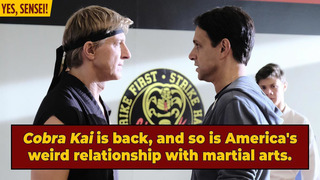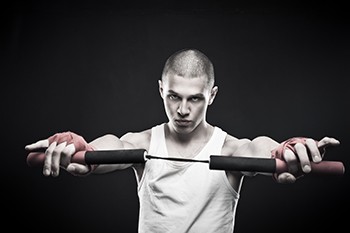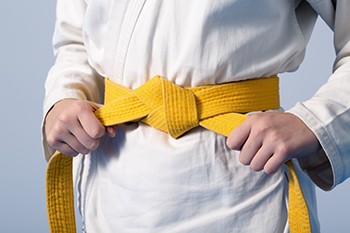'Cobra Kai' And America's Weird Old Anti-Karate Hysteria

Picking up where the original Karate Kid series left off, Netflix's Cobra Kai brings back the rivalry between Johnny Lawrence and Daniel LaRusso as their passion for San Fernando Valley teenage karate supremacy takes hold of their lives once again. Both Lawrence and LaRusso open their respective karate dojos and recruit a band of troubled high schoolers, hoping that they can instill these young pupils with the same skills in the martial arts and car washing/waxing that dominated their teenage years. The result is Street Fighter: The High School Years -- the usual school drama involving bullies, absent parents, and love triangles, all upping the ante by way of highly choreographed (and sometimes down-right brutal) fight scenes. And boy, does this show not hold back any punches.

There is something to be said about a show that depicts near senseless violence among high schoolers in 2020 with almost zero consequences. On our screens, we cheer when Miguel finally takes down a horde of crude jocks in the cafeteria, calling back to the days we wish we could've done the very same thing to our bullies. But if the same ass-kicking were to actually occur in our schools today, would we cheer? Or would we be left wondering how much worse the scene could have actually been?
Though honestly, "High school conflict DOESN'T result in shooting" could be the feel-good story of the year.
To answer these questions, we need to flip back to when the original Karate Kid and other major martial arts films came out in the 1970s-1980s and see how Americans responded then. Spoiler Alert: White suburban moms were not happy about them.
Before the Karate Kid films, there was martial arts legend Bruce Lee. His early '70s films like Fist of Fury and Enter the Dragon captivated young audiences and kicked off what would eventually become known as the "kung fu craze" in the United States. The impact of kung fu films from abroad made American youth rush to enroll in martial arts programs and develop a particular interest in one controversial element from the movies: the weapons.
Nunchucks. Throwing stars. Swords. Arguably some of the coolest aspects of martial arts movies, it's not surprising to see why these would capture the attention of young Americans, especially boys, before the advent of the internet. If you're telling me you never went in your backyard to throw sharp objects while pretending to be a ninja as a kid, I'm calling you a liar. Back in the day, these weapons were astonishingly easy to find, with throwing stars selling for anywhere from $1.00-4.50 at knife stores, army surplus stores, regular shopping malls, and even arcades.

As more and more kids got their hands on these martial arts weapons, parents, the media, and law enforcement became more concerned about what they perceived to be a growing danger to civilized society. This type of reaction isn't surprising, for we've seen it time and time again as new trends (i.e., rock music, hip hop, video games, the concept of fun, etc.) divide younger and older generations over fears of moral failings and civil unrest in our youth. Martial arts and their weapons were not spared from this social phenomenon.
In the 1970s, newspapers across the country began reporting on how these "concealed deadly weapons" were turning up in the hands of our kids, fueling the hysteria with rhetoric like "killer sticks" for nunchucks (also known as "nunchaku," always known as "rad as hell"). Law enforcement divisions were quick to crack down on these weapons. In 1973, the LAPD claimed to have made a dozen arrests in just a few weeks for 12 and 13-year-olds with throwing stars in their pockets. States across the country began banning these weapons, classifying their possession as a misdemeanor or felony and passing tighter restrictions than we've seen for some instances of firearm possession.

It's hard to determine whether the hysteria over the weapons was solely based on fear over youth exposure to violence or whether there were racist undertones involved. At this time, guns were already everywhere in American life and hardly viewed as threatening. With gun ownership hovering between 44.2%-50.5% of American households from 1973-1985, firearms were a staple of American domesticity akin to a white picket fence and a trimmed green lawn. But with remnants of "Yellow Peril" still present in America during these decades, it's not surprising to see a link between fear of these martial arts weapons and fear of East Asian peoples.
Many states explicitly called these weapons "Chinese" or "Japanese" throwing stars in their criminal codes, not unlike how racist naming associations for COVID took hold with "Wuhan flu" or "Chinese flu." The term "killer sticks" for nunchaku has its very roots in anti-Asian sentiments that have been present for decades in the United States. Martial arts practices themselves began to be viewed as wholly anti-American. This is something that Cobra Kai itself actually points out several times throughout the show. In Season 1, Episode 4, tensions come to a head when Daniel LaRusso confronts his car dealership rival for suggesting that he is unpatriotic for his love of karate.
Thankfully over the years, martial arts became a more accepted part of American culture. They've inspired video games like Street Fighter, children's cartoons like Teenage Mutant Ninja Turtles, and led to the founding of sports leagues like the Ultimate Fighting Championship (UFC). They've influenced modern renditions of martial arts films like Tarantino's Kill Bill and even inspired an episode of South Park that poked fun at the dangers associated with martial arts weapons. It's now entirely common to see suburban moms dropping their kids off at karate or taekwondo (some of us unfortunately never made it past their yellow belt).

As the hysteria over martial arts has calmed down, states are slowly beginning to reassess their bans on throwing stars and nunchaku. In New York, a federal judge overturned the ban on nunchaku, saying they are protected under the right to bear arms (or right turtle arms) in the Second Amendment. In Arizona, the governor signed a bill removing nunchaku from the list of banned weapons that included bombs and automatic firearms. Many practitioners are pushing for legal possession of these weapons for martial arts purposes, arguing that those who use the weapons for martial arts are unlikely to use them to commit crimes.
Elsewhere in the country, officials are asking why these weapons are banned when gun shows and knife shows have free reign. These arguments are pretty logical -- to quote New York lawyer James Maloney, "if you're going to commit a crime, your weapon of choice wouldn't be these two sticks." The time and resources spent enforcing these banned weapons could undoubtedly be used to tackle real issues like gun violence among youth. Seriously, why are we concerned about how much damage a kid with a few throwing stars can do when we have lawmakers and conservative pundits praising 17-year-olds who shoot protestors on the street?
In 2020, it seems that Cobra Kai is being received with much more widespread approval than its predecessors did decades ago. This is important, especially at a time when racism towards Asian people and gun violence among youth has reached peaks in America. It has yet to be seen whether the show will spark similar long-term trends of fascination and fear with martial arts culture that we've seen in the past. So far, we have yet to see any viral videos of kids leg-sweeping each other against lockers because of the show.
In the meantime, we can take Cobra Kai's success as a celebration of how martial arts has finally become an accepted part of our culture and relish it as an homage to one of the most iconic franchises in American cinema. In an era when tensions seem to be at an all-time high, it's reassuring to watch a show where its characters have total control over how they respond to their enemies -- and can actually land a punch or two. As we brace ourselves for a new year in uncharted waters, we can all apply the teachings of Cobra Kai in our own lives: Strike first, strike hard, and have no mercy.
Top image: Netflix